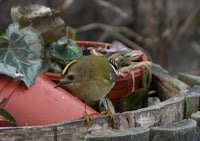What I have not mentioned before is that
the Long Tail Tits which I saw in September on the High Botany backroad, had moved about 1kilometre east when I spotted the flock flitting about this tree at the entrance of, not just anywhere, only "just" at one of the houses of the latest extension of our council estate. This tree is more or less at the entrance of the little cul de sac where we are living.
I would have been delighted any other day of the year, hoping I would be able to lure it over into our garden- (mind, we are the one at the final end of the 26 council houses.
I had just done the last of our shopping before we would leave to town for our break in the Maritime hotel over Halloween. I id mention this because they were gone, four days later.
Yesterday, I was in a little dark mood because the weather promised to keeop me housebound for the rest of this week, and after returning home from the village shop I suddenly spotted something dive behind the Fennel at the back of the planter.
With four eager Coal Tit flying about, I had trouble concentrating on this one point, and my first instinct was a Wren; it showed the same secretive behaviour.
Then suddenly, I called Francis; I was desperate for him to see Ireland's (and UK's)smallest Bird.
My hand was too shaky for a picture, but Francis told me that it would return, so don't worry. (wouldn't it be lovely to have this lax and sometimes naive way of thinking of the non-birder?)
Anyway, he was right. As you can see in the two pictures, it did return this afternoon. About the same time (1-2pm) and the weather's behaviour seemed less important: house arrest looked not too bad with a Goldcrest in my feeding station.
Mind you, it was still tempting otside, it did rained now and then for 2 or 3 minutes, but that was the problem, plus it was still very dark.
Being prepared this time, and waiting for it with camera ready, I got a few reasonable photos. Still, it was very nervous, and I still need to learn its habits; a preferred route about the planter, which food tray it prefers, does it come in from the left or the right, and how does it interact with the others?
In fact it imitates the Coal and Blue Tits a little in getting a bite (peanut cake/feeder or seed) and eating it in the Fennel, and going around the outer edge of the planter.
Late August, while I was eying a Whiffwaff (either a Willow Warbler or Chiffchaff- often too hard to tell apart) in ther Fennel with the camera to get good shots for a probable ID, a Goldcrest sat watching me, the garden and my birds from the fence before leaving again. Was it preparing for winter and searching the area for a good and safe diner to help in surving the cold winter?
I had the feeling it would come back this way, since then. A little cold can do wonders. Now all it has to do, is stay and call a few friends perhaps. ?
Goldcrest


The newcomer was observed with curiosity by all customers, it was not directly seen as a threat yet, and it was lucky not to have met the two Robins this time. These are very fierce in protecting "their" feeding station from new intruders.



The Wagtails are moving in aain too with their shrill call warning you where they are.

All you need to see are two eyes.

